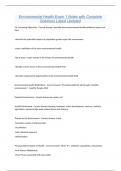Summary
Summary Business Information System - Lecture Notes and Chapters IBA
- Course
- Institution
- Book
This document contains detailed lecture notes and images of the course Business Information System. Starting from page 62, there are extra notes on the bookchapters 1,2,3,4,5,6,7,8,9,10 and the tech briefing.
[Show more]













